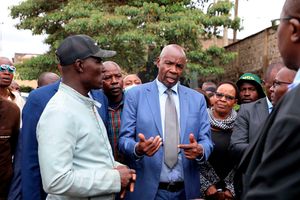Counties to open new frontiers for renewable energy

Solar panels being installed at Lunyerere in Vihiga County, Kenya, to provide hybrid power that will pump water and help cut down on the high cost of electricity bills.
What you need to know:
The future of Kenya’s energy development will depend on clean energy solutions that can improve the quality of life at community levels.
Therefore, involving county governments is key as the devolved units are responsible for certain functions in areas such as agriculture, health and early childhood education.
The 47 counties are in the best position to account for the appropriate levels for energy access to be extended into development planning.
The linking of energy access to service provision and the County Energy Plans (CEP) will result in a successful integration of the National Energy Plan (INEP) as adopted in the Energy Act (2019).
A peek into the direction the CEPs are taking is clear- Kenya’s future, if all goes as planned – is clean energy.
This realisation comes at a time when the Sustainable Energy Technical Assistance (SETA) is facilitating 16 counties to come up with their CEPs.
“Everything is anchored on renewables. That is the future,” explains Mr Jechonia Kitala, the SETA key expert.
“Our project is involving 16 counties and all of them are going green,” he explained.
Counties have a raft of proposals such as solar, mini-hydros, e-cooking, green biofuels, wind and geothermal. Further, sources like biogas are emerging as a solution in saving forests from destruction.
Meru is one of the counties leading in biogas installations. The biogas is used for cooking, lighting, heating and running machines, for example, chaff cutter.
“The opportunities are immense and we are happy that more and more households are embracing non-traditional sources of energy like biogas,” said Jean Paul Claude, head of SETA.
Kenya's energy space has been vibrant, targeting just energy transition and universal access to electricity by 2030. It is also envisaged that the country will attain the ambitious target of universal access to clean cooking by 2028 and achieve net zero target by 2050.
According to Isaac Kiva, the secretary, Renewable Energy Directorate at the Ministry of Energy and Petroleum, the completion of the CEPs is critical as they form the core components of the Integrated National Energy Plan (INEP) as espoused in the Energy Act (2019).
The total funding for SETA was Sh565 million. The funding was mainly technical support. However, about 25 counties are yet to start their CEPs.
Mr Kiva challenged counties to commit resources to finalise their CEPs so that Kenya can have consolidated INEP for rollout. Council of Governors representative Rosemary Rop observed that there are many opportunities in non-tradition energies, renewable energy solutions and liquid biofuels. She said energy is a key enabler that supports diverse sectors such as agriculture, water, health, and nutrition among others.
Mr Kiva noted that the energy portfolio is expanding and now the national government is keen on e-mobility and e-cooking that will not only expand the energy eco-system but also offer opportunities for employment, investment and improved lifestyles.
Mr Dan Marangu, the director of Renewable Energy, Ministry of Energy and Petroleum, said the project is key as it sets the path for a strategic journey towards achieving Sustainable Energy for All by 2030.
“Ultimately, we are looking at universal access to clean, reliable and affordable energy,” he noted.
Ms Elizabeth Muchiri, the director of Global LPG Partnership, said only six per cent of rural Kenya uses liquefied petroleum gas (LPG) while the national average is 26 per cent.
“Though Kenya is among the countries with high LPG uses, a lot more needs to be done to stimulate uptake. We need regulations that support safety, affordability and accessibility. That is one of the efforts the County Energy Plans is strongly proposing going forward,” she explained.
Mr Martin Andersen, head of Infrastructure and Energy, European Delegation in Kenya, lauded the country for the robust green grid that is about 90 per cent renewable. “We are proud of Kenya, and we will support the country towards 100 per cent green grid,” said Mr Andersen.
He said there are other interesting emerging areas that the EU is keen on supporting Kenya like green hydrogen, which is set to create more jobs.
Mr Andersen reaffirmed the EU’s commitment to support Kenya’s “Green Resilient Electricity System” that will strengthen transmission and stimulate the development of green energy.
Mr Kiva noted that the time is ripe to review the energy policy and streamline it like a sessional paper to give it strong anchorage in law.





